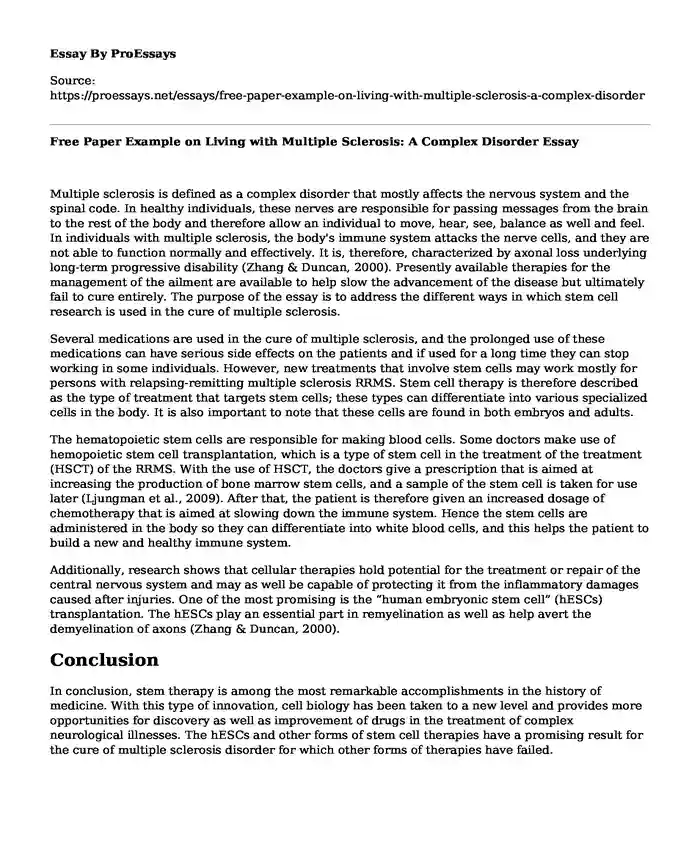Multiple sclerosis is defined as a complex disorder that mostly affects the nervous system and the spinal code. In healthy individuals, these nerves are responsible for passing messages from the brain to the rest of the body and therefore allow an individual to move, hear, see, balance as well and feel. In individuals with multiple sclerosis, the body's immune system attacks the nerve cells, and they are not able to function normally and effectively. It is, therefore, characterized by axonal loss underlying long-term progressive disability (Zhang & Duncan, 2000). Presently available therapies for the management of the ailment are available to help slow the advancement of the disease but ultimately fail to cure entirely. The purpose of the essay is to address the different ways in which stem cell research is used in the cure of multiple sclerosis.
Several medications are used in the cure of multiple sclerosis, and the prolonged use of these medications can have serious side effects on the patients and if used for a long time they can stop working in some individuals. However, new treatments that involve stem cells may work mostly for persons with relapsing-remitting multiple sclerosis RRMS. Stem cell therapy is therefore described as the type of treatment that targets stem cells; these types can differentiate into various specialized cells in the body. It is also important to note that these cells are found in both embryos and adults.
The hematopoietic stem cells are responsible for making blood cells. Some doctors make use of hemopoietic stem cell transplantation, which is a type of stem cell in the treatment of the treatment (HSCT) of the RRMS. With the use of HSCT, the doctors give a prescription that is aimed at increasing the production of bone marrow stem cells, and a sample of the stem cell is taken for use later (Ljungman et al., 2009). After that, the patient is therefore given an increased dosage of chemotherapy that is aimed at slowing down the immune system. Hence the stem cells are administered in the body so they can differentiate into white blood cells, and this helps the patient to build a new and healthy immune system.
Additionally, research shows that cellular therapies hold potential for the treatment or repair of the central nervous system and may as well be capable of protecting it from the inflammatory damages caused after injuries. One of the most promising is the “human embryonic stem cell” (hESCs) transplantation. The hESCs play an essential part in remyelination as well as help avert the demyelination of axons (Zhang & Duncan, 2000).
Conclusion
In conclusion, stem therapy is among the most remarkable accomplishments in the history of medicine. With this type of innovation, cell biology has been taken to a new level and provides more opportunities for discovery as well as improvement of drugs in the treatment of complex neurological illnesses. The hESCs and other forms of stem cell therapies have a promising result for the cure of multiple sclerosis disorder for which other forms of therapies have failed.
References
Ljungman, P., Bregni, M., Brune, M., Cornelissen, J., Witte, T. D., Dini, G., . . . Niederwieser, D. (2009). Allogeneic and autologous transplantation for hematological diseases, solid tumours and immune disorders: Current practice in Europe 2009. Bone Marrow Transplantation, 45(2), 219-234. https://doi.org/10.1038/bmt.2009.141
Zhang, S., & Duncan, I. D. (2000). Chapter 25 Remyelination and restoration of axonal function by glial cell transplantation. Functional Neural Transplantation II. Novel Cell Therapies For CNS Disorders Progress in Brain Research, 515-533. https://doi.org/10.1016/S0079-6123(00)27026-X
Cite this page
Free Paper Example on Living with Multiple Sclerosis: A Complex Disorder. (2023, Nov 18). Retrieved from https://proessays.net/essays/free-paper-example-on-living-with-multiple-sclerosis-a-complex-disorder
If you are the original author of this essay and no longer wish to have it published on the ProEssays website, please click below to request its removal:
- LODD Line of Duty Death Paper Example
- Paper Example on Diet Quality Index: Nutritional Standards for Adolescents
- Essay Sample on Nurse Practitioner Semester Goals: Learnings, Clinicals & Ethical Dilemmas
- Essay Sample on Population Health: Factors Determining Health Outcomes & Strategies for Improvement
- Essay Example on Global Healthcare Stressors: Strategies for Administration and Nursing Shortage
- Client's Readiness for Change: TTM & SDT in Action - Free Paper Example
- Research Paper Example: Educating Nurses on Polypharmacy







